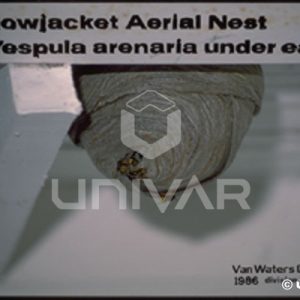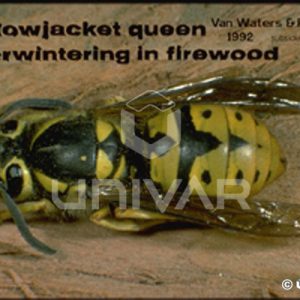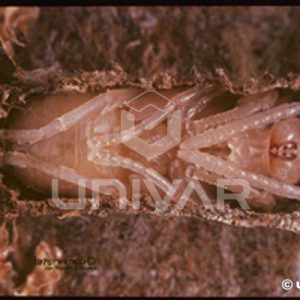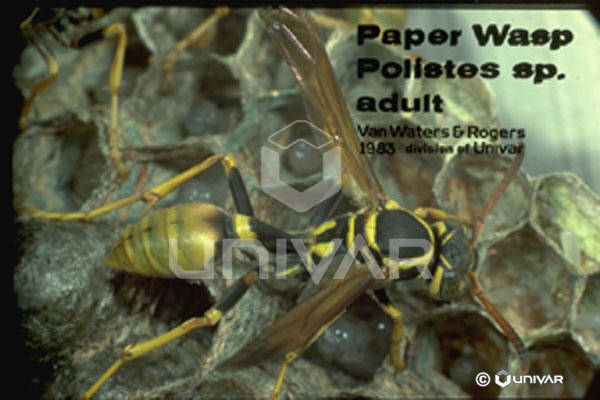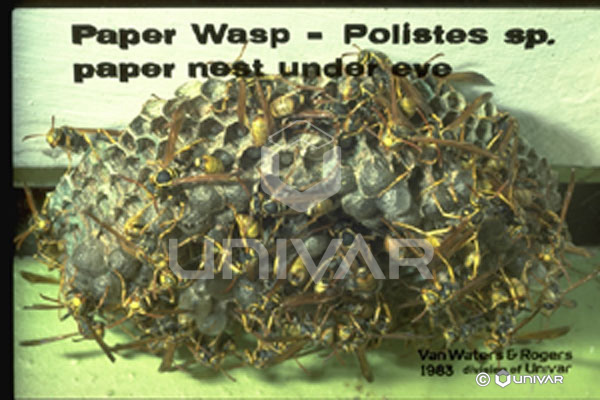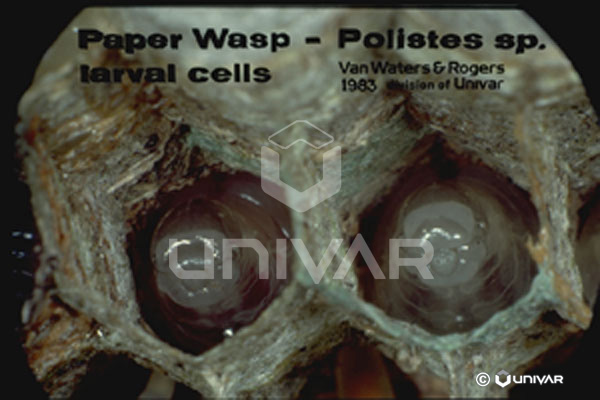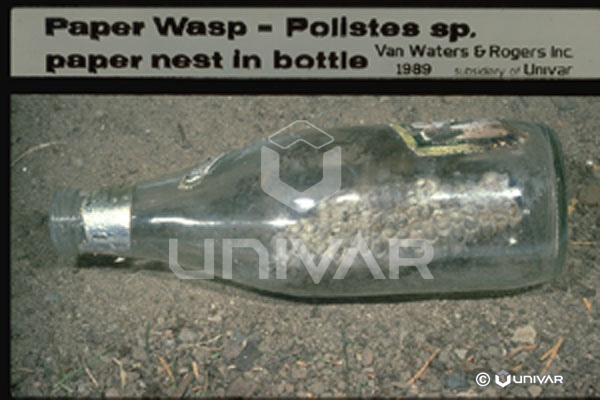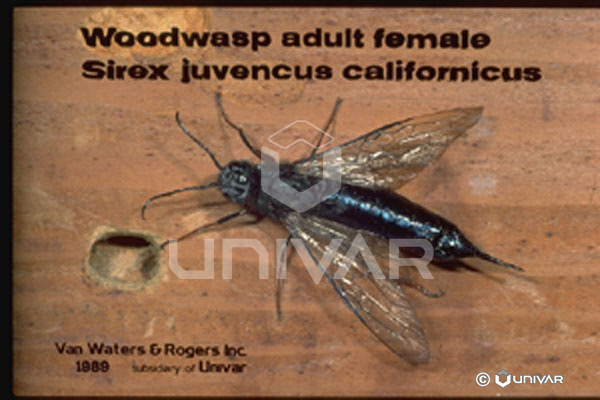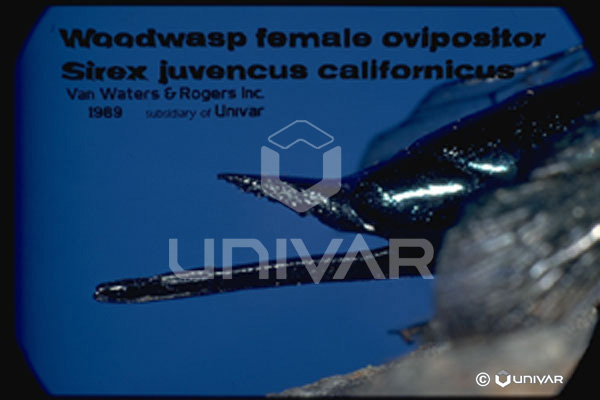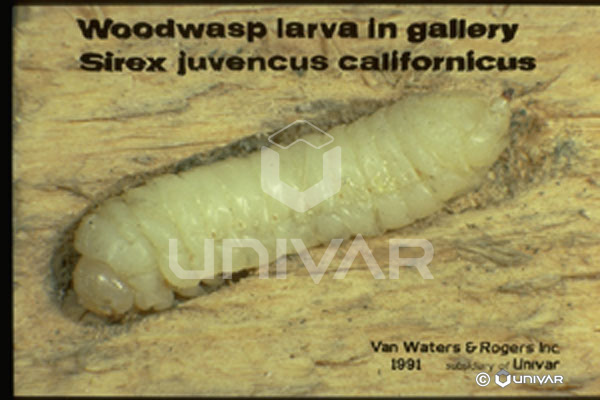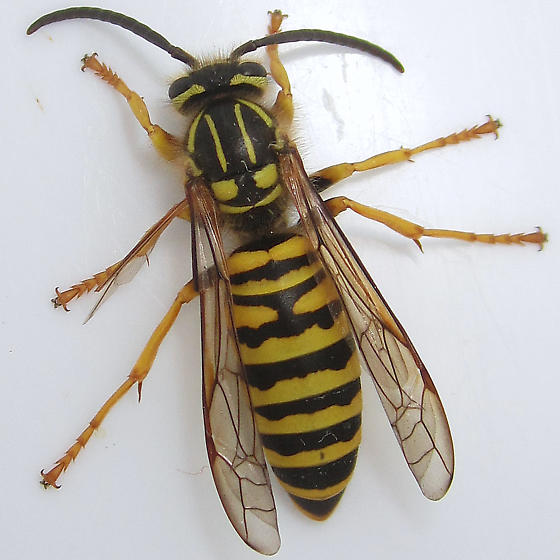
YELLOWJACKET
Common Name: Wasp – Yellowjacket
Latin Name: Vespula
Common Family Name: Vespid wasps
Latin Family Name: Vespidae
Other Names: Paper wasps, meat bees, hornets
Origin:
There are many species of Vespula in North America, including several species introduced from Europe. Vespula germanica are among the serious scavenger pests in this group.
Biology:
Yellowjackets are social wasps, with a Queen that initiates the colony and female workers that build the nest, care for the young, forage for food, and defend the colony. Colonies typically begin each spring and die off each fall in cooler climates, but may survive over the winter in warmer climates. The population of the colony easily grows to many thousands of workers by the end of the summer, at which time males are produced, mating with new queens takes place, and these fertilized queens then over-winter in protected locations. Adults feed on sweet liquids such as honeydew, nectar, fruit juices, or human foods such as sodas. They also relish a sugary material exuded by the larvae. The larvae are fed meat, and natural sources are insect larvae or bits of flesh from dead animals. As scavengers the workers also gather human foods at outdoor eating areas. The workers are all able to sting repeatedly, and very aggressively defend their colony from perceived intruders. Nests are placed either in aerial locations, including trees, shrubs, wall voids, or attics, as well as in the ground, where workers enlarge holes they find to accommodate the growing colony. The nest is created from cellulose gathered from tree bark, dried plant materials, or other sources, mixed with saliva, and formed as hexagonal cells for the larvae.
Identification:
Yellowjackets are very similar to the other social paper wasps called Umbrella Wasps but differ by having no narrow waist between their thorax and abdomen. Colors are yellow and black, and specific identification of each species is done with differences in the patterns of the black patches around the eyes and head as well as on the abdomen. Yellowjackets, as wasps, have 2 pairs of wings that are dissimilar in size and shape. This separates them from many species of flies that mimic wasps, where there is only 1 pair of wings.
Characteristics Important in Control:
Elimination of attractions such as spilled food materials or rotting fruits in gardens will help to prevent the presence of yellowjackets. If they are nesting within a structure the nest itself or openings the workers use for entry may be dusted with a residual insecticide. Baiting using meat or syrups as the attraction will work very well if a product labeled for use in this manner becomes available. Trapping will capture many of the foraging workers around human activity areas, but is unlikely to cause a large reduction of the nest population.
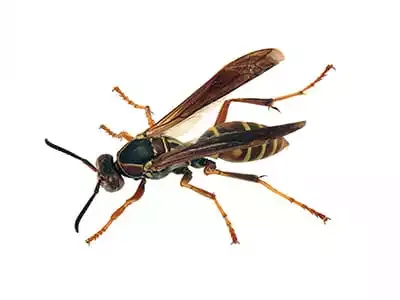
PAPER WASP
Common Name: Wasp – Umbrella wasp
Latin Name: Polistes
Common Family Name: Vespid wasps
Latin Family Name: Vespidae
Other Names: Paper wasp
Origin: Many species of these wasps are native insects in North America.
Biology: The umbrella wasps derive their name from the upside-down umbrella shape of their nests. They are closely related to yellowjackets, but have smaller colonies, exposed cells in the nest, and are not the annoying scavengers on human foods that yellowjackets are. These wasps are a nuisance when they sting someone who gets too near their hive or when they are foraging for food in orchards or backyard gardens. Adults feed on sugary liquids but gather natural foods such as insect larvae to feed to their own offspring. Colonies do not survive the winter but are started by a single fertilized female which is over-wintered in a protected location. The nest is created from chewed bark, dried plant parts, or other cellulose materials, and the cells in which the larvae will grow are formed in the traditional hexagon shape. Once the first adults emerge they become the workers and the original female, or “queen”, settles into laying eggs. All members of the colony are females and all of them can sting.
Identification: Umbrella wasps are very similar to yellowjackets, but they have a thin waist between their abdomen and thorax, unlike the tightly joined abdomen and waist of the yellowjacket. They are large wasps, usually about one inch long, and colors are yellow with black, orange, or reddish brown. Colonies may eventually contain several hundred workers and usually consist of a single, flat, very wide nest. The adult workers rest on this at night. It is common for these nests to be built under eaves or in attics.
Characteristics Important in Control: Physical removal is effective if care is taken, particularly doing so at night when the adult wasps are not active but are resting on the nest. The adults may also be killed with a directed stream of insecticide from an aerosol designed for these wasps. Once the adults are killed the nest can be removed and disposed of.
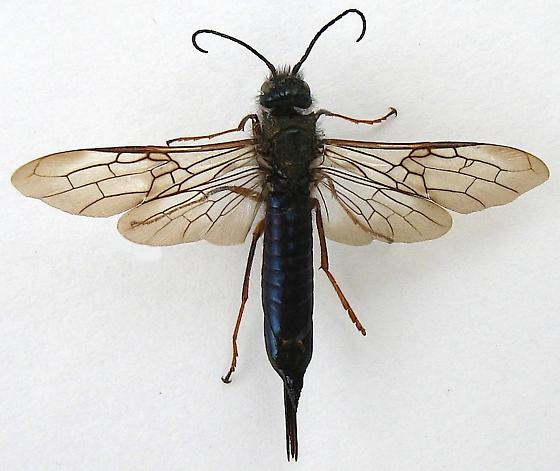
HORNTAIL WASP
Common Name: Wasp – Horntail wasp
Latin Name: Sirex
Common Family Name: Horntails
Latin Family Name: Siricidae
Other Names: Wood wasps
Origin: About 18 species of horntail wasps are native to North America, with most species in the western half of the continent.
Biology: The horntail wasps derive their name from the presence of a horn-like projection on the top of the last segment of the abdomen of the female. These are solitary wasps whose larvae feed within the sound wood of dead trees, gathering their nourishment from a fungus that grows with them as they bore through the wood. The female wasp will lay her eggs only on the bark of trees, injecting them below the surface. In this way it is common for lumber to be milled with the wasp larvae already in it, allowing the larvae then to be built into a structure. The wasps will not infest wood already in use. Once the adult wasp develops it bores its way out of the wood through whatever is in its way, creating pencil-sized round holes in sheetrock, paneling, wallpaper, or even tiles. The adults then go to lighted windows to attempt to escape. These wasps cannot sting or bite, but due to their large size and loud flight are greatly feared by occupants of the structure in which they emerge.
Identification: Wood wasps can be over 2 inches long in females, from head to tip of ovipositor. They are black or metallic blue or with bands of yellow or orange on them. The females have a very long, thick ovipositor extending directly behind their abdomen. The abdomen is elongated with parallel sides, it is joined broadly to the thorax, and the antennae are somewhat curled. The larva of a wood wasp is similar to wood-boring beetle larvae, but it has a short, sharp spine on its rear end. It has 3 pairs of very short legs and no abdominal prolegs.
Characteristics Important in Control: When these wasps are emerging from structural wood members it is best to allow them to run their course, and once all the wasps have emerged the holes can be repaired. There is little damage done, and normally the small number of wasps present do not warrant fumigation or other control measures. They will not reinfest.

